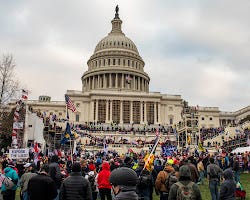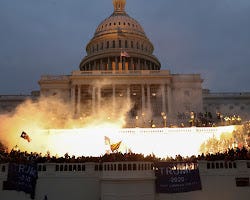January 5, 2021: Two pipe bombs are found outside the Democratic National Committee and Republican National Committee headquarters in Washington, D.C.

January 6, 2021:
* Morning: Trump holds a rally near the White House, where he repeats false claims about the election being stolen. He tells his supporters to “fight like hell” to keep him in power.
* Afternoon: Congress begins a joint session to count the electoral college votes.
- 1:00 PM: A mob of Trump supporters storms the Capitol, forcing lawmakers to evacuate.

- 2:15 PM: The mob breaks into the Capitol building.

* 3:00 PM: Vice President Mike Pence is evacuated from the Senate.
- 4:00 PM: Trump tells his supporters to go home, but they refuse.

* 5:00 PM: The Capitol is secured.
* 6:00 PM: Muriel Bowser, the mayor of Washington, D.C., declares a curfew.
The insurrection resulted in the deaths of five people, including a Capitol Police officer. Over 700 people have been arrested in connection with the attack, and hundreds more are still being investigated.
The January 6th insurrection was a direct assault on American democracy. It is important to remember and learn from this event so that it never happens again.
In addition to the timeline, here are some other important facts about the January 6th insurrection:
* The attack was planned and organized for weeks in advance.
* Many of the rioters were armed with weapons, including guns, knives, and clubs.
* The rioters vandalized the Capitol building, stole government property, and assaulted police officers.
* The attack was an attempt to prevent Congress from certifying the results of the 2020 presidential election.
The January 6th insurrection was a dark day for American democracy. However, it is important to remember that democracy is resilient. The United States has survived other challenges in its history, and it will survive this one as well.
Congressional Reports and Analysis Studies
The timeline of the January 6th insurrection at the US Capitol. Here are some possible resources to explore:
1. United States Senate Committee on Homeland Security and Governmental Affairs: The committee conducted an investigation into the security and intelligence failures surrounding the January 6th insurrection. Their website may have relevant reports and analysis.
2. United States House Select Committee on the January 6th Attack: This committee was established specifically to investigate the events of January 6th. They may release reports, analysis, and findings related to the timeline of the insurrection.
3. Congressional Research Service (CRS): The CRS is a nonpartisan research arm of the United States Congress. They provide reports and analysis on various topics, including the January 6th insurrection. These reports can offer insights into the timeline and related issues.
4. Government Accountability Office (GAO): The GAO is an independent agency that provides auditing, evaluation, and investigative services to Congress. They may have conducted studies or issued reports related to the events of January 6th.
5. Congressional Hearings and Testimonies: Congressional hearings conducted by relevant committees can provide valuable insights into the timeline of the insurrection. These hearings often include witness testimonies and expert analysis.
To access specific reports or studies, visit the websites of the respective committees, agencies, or organizations mentioned above. Additionally, you can search their databases or contact them directly for more information.
Remember to critically evaluate the information you find, considering factors such as the credibility of the source, the methodology used, and the relevance to your specific research.
Independent Research and Studies
Independent research and studies conducted on the timeline of the January 6th insurrection at the US Capitol provide valuable insights into the events that unfolded on that day. These studies are often conducted by academic institutions, think tanks, or independent researchers who aim to analyze the sequence of events, identify key factors, and understand the implications of the insurrection. While I don’t have access to real-time information on specific studies, I can provide you with some general information on the types of independent research and studies that may exist:
1. Academic Research: Universities and research institutions may conduct studies on various aspects of the January 6th insurrection. These studies might analyze the motivations of the individuals involved, the impact on democratic institutions, or the role of social media in organizing the event.
2. Think Tank Reports: Think tanks often engage in policy research and analysis. They may publish reports that provide a comprehensive timeline of the insurrection, along with insights into the underlying causes, security failures, and potential policy recommendations to prevent similar incidents in the future.
3. Legal and Constitutional Analysis: Scholars specializing in constitutional law or legal studies may conduct research to analyze the legal implications of the insurrection. These studies might examine the legality of the actions taken by the individuals involved, the potential charges they may face, or the constitutional ramifications of the event.
4. Social and Political Science Studies: Researchers in the field of social and political sciences may explore the social and political factors that contributed to the insurrection. These studies might examine the role of political polarization, the impact of disinformation campaigns, or the mobilization of extremist groups.
5. Media and Communication Studies: Scholars focusing on media and communication may analyze the role of traditional and social media in shaping the narrative around the insurrection. These studies might investigate how information was disseminated, the impact of misinformation, or the role of online platforms in facilitating the organization of the event.
To access specific independent research and studies on the timeline of the January 6th insurrection, you can search academic databases, visit the websites of relevant research institutions or think tanks, or consult scholarly journals in the respective fields. It is important to critically evaluate the credibility, methodology, and relevance of the research to ensure its reliability and accuracy.
Independent Research Polls Taken of the Insurrection
January 6th insurrection at the US Capitol. These polls aim to gauge public opinion and perceptions related to the events that unfolded on that day. Here are some possible topics that polls might have covered:
1. Awareness and Knowledge:
- Did respondents have awareness of the events that transpired on January 6th?
- How closely were they following the news and developments related to the insurrection?
- Did they have a basic understanding of the timeline of events?
2. Perception of Security and Preparedness:
- How do respondents perceive the security and preparedness measures in place on January 6th?
- Do they believe that law enforcement agencies were adequately prepared for the events?
- Are they satisfied with the response of law enforcement during the insurrection?
3. Assessment of Political Responsibility:
- Who do respondents believe bears responsibility for the events of January 6th?
- Do they think that political leaders or specific groups played a role in inciting the insurrection?
- Are they satisfied with the accountability measures taken against those involved?
4. Impact on Democracy:
- How do respondents perceive the impact of the insurrection on American democracy?
- Are they concerned about the implications of the events for the functioning of democratic institutions?
- Do they believe that the events of January 6th pose a threat to the democratic process?
5. Calls for Investigation and Justice:
- Do respondents support the establishment of investigative committees or commissions to examine the timeline of the insurrection?
- Are they in favor of holding those responsible accountable through legal means?
- Do they have confidence in the justice system’s ability to handle cases related to the insurrection?
To access specific polls conducted on the timeline of the January 6th insurrection, you can search reputable polling organizations, news outlets, and research institutions. Keep in mind that polls may vary in terms of sample size, methodology, and demographic representation, so it’s important to critically evaluate their findings and consider the context in which they were conducted.
Resources and Sources
When researching a timeline of the January 6th insurrection at the US Capitol, here are some resources and sources to consider:
1. Official Reports and Documents:
- The United States Senate Committee on Homeland Security and Governmental Affairs: The committee released a bipartisan report on the security and intelligence failures surrounding the insurrection.
- The United States House Select Committee on the January 6th Attack: This committee is currently conducting an investigation into the events of January 6th and may release relevant documents and reports.
2. News Outlets and Media Coverage:
- The New York Times: The Times has published extensive coverage of the events of January 6th, including timelines and detailed accounts.
- CNN: CNN offers a comprehensive timeline of the insurrection, including key moments and developments.
- The Washington Post: The Post’s coverage includes a timeline of events, analysis, and firsthand accounts.
3. Government Statements and Press Releases:
- The Federal Bureau of Investigation (FBI): The FBI has released statements, updates, and press releases regarding ongoing investigations into the insurrection.
- The Department of Justice (DOJ): The DOJ has issued press releases on the arrests, charges, and prosecutions related to the events of January 6th.
4. Social Media and Open Source Investigations:
- Bellingcat: Bellingcat is an open-source investigative journalism organization that has conducted in-depth investigations into the events of January 6th, using social media and publicly available information.
5. Nonprofit Organizations and Research Institutions:
- The Center for Strategic and International Studies (CSIS): CSIS provides analysis and research on a wide range of topics, including domestic extremism and security threats.
- The Brennan Center for Justice: The Brennan Center offers research and analysis on issues related to democracy, including the insurrection and its implications.
Remember to critically evaluate the information from these sources, considering their credibility, objectivity, and potential biases. Gathering insights from multiple sources will help you build a comprehensive and accurate timeline of the January 6th insurrection at the US Capitol.
Prevented Measures and Methods Plus Regulations to be Put in Place
The January 6th insurrection at the US Capitol served as a wake-up call, highlighting the need for preventive measures to ensure that such occurrences are not repeated in the future. Several key areas have been identified for improvement to enhance security, address underlying factors, and safeguard democratic institutions. Here are some methods that have been discussed to prevent similar incidents from happening again:
1. Strengthening Security Measures:
- Enhancing physical security: This includes fortifying the physical barriers and infrastructure around government buildings to better deter and prevent unauthorized access.
- Improving intelligence sharing: Enhancing coordination and information sharing among law enforcement agencies at the federal, state, and local levels to identify potential threats and respond effectively.
- Evaluating security protocols: Conducting thorough assessments of existing security protocols and procedures, identifying vulnerabilities, and implementing necessary changes to ensure a robust security apparatus.
2. Addressing Extremism and Radicalization:
- Countering disinformation and conspiracy theories: Developing comprehensive strategies to combat the spread of false information and conspiracy theories that contribute to radicalization and extremist ideologies.
- Strengthening online platform regulations: Collaborating with social media companies to establish stricter regulations and monitoring mechanisms to prevent the dissemination of extremist content and the organization of violent events.
- Investing in community-based interventions: Supporting programs that promote social cohesion, tolerance, and dialogue to prevent the radicalization of individuals in vulnerable communities.
3. Accountability and Legal Measures:
- Prosecuting those responsible: Ensuring that individuals involved in the insurrection are held accountable through fair and thorough investigations, prosecutions, and appropriate legal consequences.
- Investigative committees and commissions: Establishing independent committees or commissions to conduct comprehensive investigations into the events of January 6th, identify shortcomings, and provide recommendations for preventing future incidents.
- Strengthening laws against domestic terrorism: Evaluating and potentially strengthening existing legislation to address the unique challenges posed by domestic extremism and terrorism.
4. Political and Civic Engagement:
- Promoting responsible leadership: Encouraging political leaders to prioritize unity, respect for democratic norms, and the peaceful resolution of disputes.
- Encouraging civic education: Strengthening civic education programs to promote a deeper understanding of democratic principles, the importance of peaceful transitions of power, and the value of active citizen participation.
5. Learning from International Examples:
- Studying international best practices: Analyzing the experiences and strategies employed by other countries that have faced similar challenges to prevent and respond to threats against democratic institutions.
- Engaging in international cooperation: Collaborating with international partners to share knowledge, resources, and expertise in countering extremism, enhancing security, and protecting democratic values.
Implementing these methods requires a comprehensive and multi-faceted approach involving government agencies, law enforcement, civil society organizations, and the public. It demands ongoing commitment to adapt and evolve preventive measures in response to emerging threats and changing circumstances.

No comments:
Post a Comment
Welcome to Leave a Comment